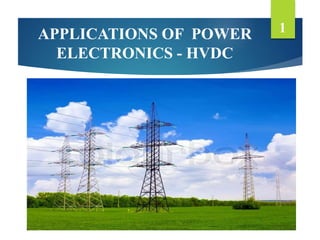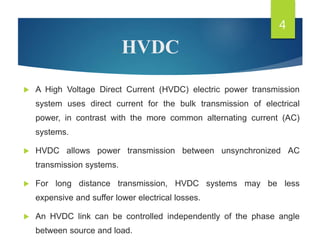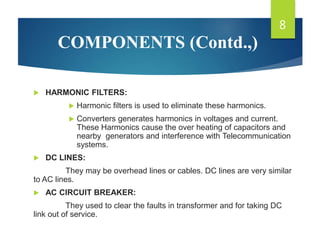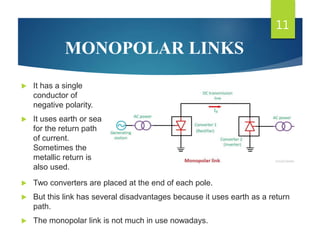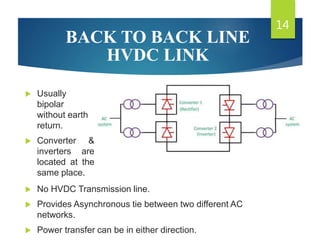Applications of power electronics in HVDC
- 1. APPLICATIONS OF POWER ELECTRONICS - HVDC 1
- 2. CONTENTS  Introduction  HVDC  Need for HVDC  Components of HVDC  Types of HVDC Links  Advantages  Disadvantages  Conclusion 2
- 3. INTRODUCTION  Power Electronics is the study of switching electronic circuits in order to control the flow of electrical energy.  It is literally impossible to list all the applications of power electronics today, as it has penetrated almost all the fields.  Some of the few are listed below,  Aerospace and Defense  Automotives and Traction  Home Appliances  Telecommunication  Utility System and Renewable energy 3
- 4. HVDC  A High Voltage Direct Current (HVDC) electric power transmission system uses direct current for the bulk transmission of electrical power, in contrast with the more common alternating current (AC) systems.  HVDC allows power transmission between unsynchronized AC transmission systems.  For long distance transmission, HVDC systems may be less expensive and suffer lower electrical losses.  An HVDC link can be controlled independently of the phase angle between source and load. 4
- 5. NEED FOR HVDC  As the load demand increases, for higher efficiency there must be only two possibilities,  To increase the generation  Minimize the losses  The losses which occur at all the stages in the system at generation, transmission and distribution level.  As the losses are greater in AC than DC, the losses can be greatly reduced by HVDC transmission.  Although there are certain in advantages of HVDC systems but also have the limitations. 5
- 6. COMPONENTS OF HVDC  Converters  Smoothing reactors  Harmonic filters  Reactive power supplies  Electrodes  DC Lines  AC Circuit breakers 6
- 7. COMPONENTS (Contd.,) 7  CONVERTERS: Perform AC to DC and DC to AC conversion. HVDC converters are usually built as 12-pulse circuits. Consists of valve bridges and transformer.  SMOOTHING REACTORS: Smoothing Reactors are serially connected reactors inserted in DC systems to reduce harmonic currents and transient over currents and/or current ripples in DC systems. Prevent commutation failure in inverter.
- 8. COMPONENTS (Contd.,)  HARMONIC FILTERS:  Harmonic filters is used to eliminate these harmonics.  Converters generates harmonics in voltages and current. These Harmonics cause the over heating of capacitors and nearby generators and interference with Telecommunication systems.  DC LINES: They may be overhead lines or cables. DC lines are very similar to AC lines.  AC CIRCUIT BREAKER: They used to clear the faults in transformer and for taking DC link out of service. 8
- 9. COMPONENTS (Contd.,)  REACTIVE POWER SUPPLIER: Under steady state condition, the reactive power consumed by the converter is about 50% of the active power transferred. Under transient conditions it could be much higher. For a strong AC power system, this reactive power is provided by a shunt capacitor.  ELECTRODES : Electrodes are conductors that provide connection to the earth for neutral and they have large surface to minimize current and surface voltage gradients. 9
- 10. TYPES OF HVDC LINKS  Monopolar links  Bipolar links  Homopolar link  Back to Back Links  Multi terminal links 10
- 11. MONOPOLAR LINKS 11  It has a single conductor of negative polarity.  It uses earth or sea for the return path of current. Sometimes the metallic return is also used.  Two converters are placed at the end of each pole.  But this link has several disadvantages because it uses earth as a return path.  The monopolar link is not much in use nowadays.
- 12. BIPOLAR HVDC LINK 12  The Bipolar link has two conductors one is positive, and the other is negative to the earth.  The midpoints of the converter stations are earthed through electrodes.  Advantage: If any of their links stop operating, the link is converted into Monopolar mode because of the ground return system. The half of the system continues supplies the power.
- 13. HOMOPOLAR HVDC LINK 13  It has two or more conductors all having the same polarity, usually negative  Since the corona effect in DC transmission lines is less for negative polarity.  The return path for such a system is through ground.  The homopolar system is not used presently.
- 14. BACK TO BACK LINE HVDC LINK 14  Usually bipolar without earth return.  Converter & inverters are located at the same place.  No HVDC Transmission line.  Provides Asynchronous tie between two different AC networks.  Power transfer can be in either direction.
- 15. MULTIPLE TERMINAL HVDC LINK 15  There are two possible connection for MT HVDC Schemes: Constant voltage parallel scheme Constant current series scheme Three or more terminals connected in parallel, some feed power and some receive power from HVDC Bus.
- 16. ADVANTAGES  Loss is very less as no frequency reversals taken into account  Interconnection of asynchronously operated power Systems  Absence of transmission line limitations  Simple in construction  Fast change of energy flow i.e. Ability of quick and bidirectional control of energy flow  Lesser corona loss and radio interference  Greater reliability  Can be used for submarine and underground transmission  Low cost of DC lines, cables and Insulators and towers. 16
- 17. DISADVANTAGES 17  Use of converters ,filters etc increases the overall cost  Expensive inverters with limited overloading capacity  DC circuit breakers are more expensive  HVDC converters have low overloading capacity  More maintenance is required for insulators  Voltage transformation is possible only on AC side  Higher losses in the static inverter at smaller transmission
- 18. 18

